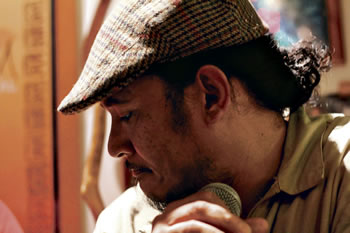Cookie Cutter Shark Lore Of 1874

Kalama Cabigon. Tina Aiu photo
Several months ago I shared the story of Maui swimmer Mike Spalding, who researchers confirmed was the first human to survive a cookie cutter shark bite. Storyteller Kalama Cabigon says the story instantly grabbed his attention.
“When I read your first article in MidWeek about Mike Spalding, his name jumped out at me,” says Cabigon, who attended Saint Louis School and the University of Hawaii. “Mike hosted halau during Hawaiian competition workshops on Maui, and I told myself, he’s not the first guy to survive a cookie cutter shark attack. I know of somebody else who did.”
Cabigon thought about contacting me but never did. Then last month I shared another story of my bizarre fascination with the nasty species and the rare opportunity I got to see and touch an old specimen. He says that’s when he knew he had to share his similar fascination with the mystery creature.
His interest started in 1994 after reading a story written on May 23, 1874, in a Hawaiian newspaper called Ka Nupepa Ku’oko’a.
“I used to spend the loose change in my pocket reading stories on old microfiche at the library,” Cabigon says with a laugh. “One headline caught my eye. It read in Hawaiian, ‘Kanaka Nahuia E Ka Mano’ or ‘Man Bitten by a Shark.'”
The chanter, musician, actor, slam poet and student of kumu hula John Keola Lake says the article spoke of two men, Wailehua and Kahaleluhi’ole, who were part of a large group that went fishing in canoes on the night of May 18, 1874, somewhere between “Waikiki Kai and Kalihi Kai.”
“They were laying net in deep water trying to catch flying fish,” says Cabigon, who carefully translated the Hawaiian words into English. “They were watching the fish enter the net when Wailehua jumped in. As they started pulling the nets in, that’s when a shark was seen among the men. Wailehua saw the shark heading toward him with his open mouth. He tried to swim over the nets, but he was bitten.”
Cabigon says the author of the story described the bite. “It broke flesh on his papa (buttock),” he says. “Wailehua tried to fend off the animal, but the shark bit him again on his left hand before getting caught in the net.”
According to the story, Cabigon says everyone jumped in their canoes and hauled in the mysterious creature. “It was not even a meter in length and its head was not like other sharks,” says Cabigon as he read the story. “It was long, but there was no dorsal fin. His head was like a square, like a box, not pointy and tapered back like other sharks. His head was blunt, and above his big eyes was fuzzy, like eyebrows. Above his upper lip was fuzzy, too, and it did not die immediately.”
The fishermen tried to burn the shark in several piles of firewood, but “his head lasted the longest and it would not catch fire.” Wailehua described feeling great pain from the bites but no weakness or sickness. He would survive. For years Cabigon wondered what kind of shark bit Wailehua. He says he found his answer eight years later on a poster showing the different types of sharks found in Hawaiian waters.
“I saw the picture of a cookie cutter shark, and I said that’s got to be it,” says an excited Cabigon. “The location of its eyes, its powerful jaw and the shape of its head were similar to what was described in the story. The fishermen obviously didn’t call it a cookie cutter shark, but it had to be one. I believe Wailehua was the first human to survive a cookie cutter shark bite in 1874.”
There’s no way to ever scientifically confirm this story, and it’s not necessary. Cabigon says what’s more important is that many stories of Hawaii’s rich history are being unveiled for the rest of the world to see and read: “There’s a wealth of information in Hawaiian newspapers that has not been glimpsed at or even seen by the Western world or modern Hawaii. Now it’s coming out!” And perhaps, in some cases, even setting the record straight.





